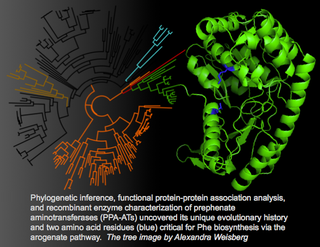Difference between revisions of "Maeda Lab:Research"
| (3 intermediate revisions by the same user not shown) | |||
| Line 17: | Line 17: | ||
<h3><font>Research Interests in Maeda Lab</font></h3> | <h3><font>Research Interests in Maeda Lab</font></h3> | ||
| − | + | Maeda Lab at University of Wisconsin-Madison studies evolutionary diversification of core metabolic pathways (i.e. primary metabolism) in various plants through chemical, biochemical, genetic, and evolutionary analyses. Utilizing the acquired basic knowledge, we further aim to redesign plant metabolic network and improve chemical compositions of agricultural and bioenergy crops, such as for improved food nutrition, plant-based bioenergy and pharmaceutical production. | |
| − | + | [[Image:200118lab.jpg|center|750px|]] | |
| − | [[ | + | Plants produce a diverse array of secondary (specialized) metabolites, which play critical roles in plant adaption to various ecological niches. In contrast to well-documented diversification of plant secondary metabolism, primary metabolism, which provides precursors of secondary metabolites, is generally thought to be conserved across different plant species. However, our lab has uncovered <font face=arial color=blue>'''lineage-specific diversifications of primary metabolic pathways'''</font> in different plant groups, likely to support downstream synthesis of diverse secondary metabolites ([[Maeda_Lab:Publications |Schenck et al. 2015; 2017a; Lopez-Nieves et al. 2018; 2022; Maeda 2019a]]). Such basic knowledge of the interface between plant primary and secondary metabolism will be crucial for future breeding, metabolic engineering, and synthetic biology to improve sustainable production of natural and bio-products from CO2 using plants as chemical production platforms ([[Maeda_Lab:Publications |Maeda 2019b]]). |
| + | |||
| + | We are conducting various projects that primarily focus on <font face=arial color=blue>'''aromatic amino acid biosynthesis'''</font>, which connects central carbon metabolism and diverse plant natural product pathways. We are further '''i)''' exploring other examples of primary metabolic diversity in the aromatic amino acid pathways, '''ii)''' investigating underlying genetic and biochemical mechanisms, '''iii)''' utilizing the knowledge to engineer aromatic amino acid biosynthesis and improve precursor metabolite availability, and '''iv)''' analyzing physiological impacts of metabolic engineering on plant growth and development. More recently, we are investigating <font face=arial color=blue>'''how nitrogen (N) flows through plant metabolic network'''</font> via the large and ancient enzyme family of aminotransferases (ATs) | ||
| Line 28: | Line 30: | ||
*Combining evolutionary biochemistry, metabolomics, and phylogenomic analyses, we are further exploring evolutionary alterations of tyrosine biosynthesis and their impacts on associated metabolic network in various plant lineages. The study can advance our understanding of the step-wise evolution of complex metabolic traits at macroevolutionary scale and explore how the evolution of such traits influence subsequent adaptation and diversification in plants. As a part of broader impact activity, we will be also generating '''chemotaxonomic databases''' together with students to study evolutionary history, mechanism, and functions of tremendous chemical diversity that exist in the plant kingdom. | *Combining evolutionary biochemistry, metabolomics, and phylogenomic analyses, we are further exploring evolutionary alterations of tyrosine biosynthesis and their impacts on associated metabolic network in various plant lineages. The study can advance our understanding of the step-wise evolution of complex metabolic traits at macroevolutionary scale and explore how the evolution of such traits influence subsequent adaptation and diversification in plants. As a part of broader impact activity, we will be also generating '''chemotaxonomic databases''' together with students to study evolutionary history, mechanism, and functions of tremendous chemical diversity that exist in the plant kingdom. | ||
*''Collaborators: [https://bsc.ua.edu/profiles/michael-mckain/ '''Michael McKain'''] (Univ. Alabama), [https://jlmlab.wixsite.com/jlmlab '''James Leebens-Mack'''] (Univ. Georgia), [https://cbs.umn.edu/contacts/ya-yang '''Ya Yang'''] (Univ. Minnesota), [https://www.plantsci.cam.ac.uk/directory/brockington-sam '''Samuel Brockington'''] (Univ. Cambridge), and [http://blackrim.org '''Stephen Smith'''] (Univ. Michigan)'' | *''Collaborators: [https://bsc.ua.edu/profiles/michael-mckain/ '''Michael McKain'''] (Univ. Alabama), [https://jlmlab.wixsite.com/jlmlab '''James Leebens-Mack'''] (Univ. Georgia), [https://cbs.umn.edu/contacts/ya-yang '''Ya Yang'''] (Univ. Minnesota), [https://www.plantsci.cam.ac.uk/directory/brockington-sam '''Samuel Brockington'''] (Univ. Cambridge), and [http://blackrim.org '''Stephen Smith'''] (Univ. Michigan)'' | ||
| − | *''Read more at '''our NSF PGRP project website''' | + | *''Read more at [https://hiroshilab.github.io/PGRP/ '''our NSF PGRP project website'''] '': |
Latest revision as of 07:29, 22 September 2023
Research Interests in Maeda LabMaeda Lab at University of Wisconsin-Madison studies evolutionary diversification of core metabolic pathways (i.e. primary metabolism) in various plants through chemical, biochemical, genetic, and evolutionary analyses. Utilizing the acquired basic knowledge, we further aim to redesign plant metabolic network and improve chemical compositions of agricultural and bioenergy crops, such as for improved food nutrition, plant-based bioenergy and pharmaceutical production. Plants produce a diverse array of secondary (specialized) metabolites, which play critical roles in plant adaption to various ecological niches. In contrast to well-documented diversification of plant secondary metabolism, primary metabolism, which provides precursors of secondary metabolites, is generally thought to be conserved across different plant species. However, our lab has uncovered lineage-specific diversifications of primary metabolic pathways in different plant groups, likely to support downstream synthesis of diverse secondary metabolites (Schenck et al. 2015; 2017a; Lopez-Nieves et al. 2018; 2022; Maeda 2019a). Such basic knowledge of the interface between plant primary and secondary metabolism will be crucial for future breeding, metabolic engineering, and synthetic biology to improve sustainable production of natural and bio-products from CO2 using plants as chemical production platforms (Maeda 2019b). We are conducting various projects that primarily focus on aromatic amino acid biosynthesis, which connects central carbon metabolism and diverse plant natural product pathways. We are further i) exploring other examples of primary metabolic diversity in the aromatic amino acid pathways, ii) investigating underlying genetic and biochemical mechanisms, iii) utilizing the knowledge to engineer aromatic amino acid biosynthesis and improve precursor metabolite availability, and iv) analyzing physiological impacts of metabolic engineering on plant growth and development. More recently, we are investigating how nitrogen (N) flows through plant metabolic network via the large and ancient enzyme family of aminotransferases (ATs)
COMPLETED PROJECTS Defining the Tyrosine Biosynthetic Pathways in Plants Funded by NSF IOS grant-1354971, 9/01/2014 – 8/31/2018
|






